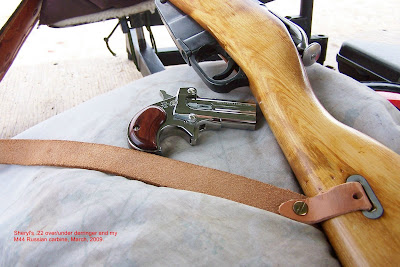











,+Oberndorf+.22.jpg)
Aric and his little son AJ and I shot .22 rifles for about 4 hours today. We actually lost track of time. There was no boredom, no sense of having to be somewhere else doing something else. We simply immersed ourselves in the business of having fun and getting serious about it.
Some people shoot simply because it is a means to an end, such as hunters. They love to hunt, so they shoot. I, on the other hand, have loved shooting since my teens. Whether I hunt or not, I always love to shoot. I love the history of shooting and all the technical advancements that have been made down through the centuries since the Chinese hand cannon. The legend and lore of shooting are fascinating. The things people believed about firearms and about the ammunition they burned are at once charming and pitiful. In the late Middle Ages, as firearms were becoming more common among Europeans, the strong hold that the Holy Roman Catholic Apostolic Church had on the minds and thought processes of the people manifest itself frequently in their questions, fears, hopes, and beliefs about the new wonder weapons from the far east.
A ball or bullet's bounce can damage one side of it and cause it to tumble and spin violently through the air, resulting in a whistling or whining sound as the projectile suddenly changes course. We all know that sound as ricochet and we understand what causes it. But for some centuries, it was commonly believed that a demon rode each ball and that the scream of the demon was what people heard when a ricochet occured. Some other people believed that leading a moving target was unnecessary, because the bullet was going so fast that it arrived instantly with no lapse in time. They ought to see the new Model 777 canon which can fire four or five rounds in a row with near perfect accuracy at 20 miles and can fire them all at different muzzle velocities and different arcs (trajectories) so that they all arrive on the target simultaneously. Imagine a hostile tank taking not one but five direct hits all at once, because there was no first or second shot to warn the crew that they were under attack.
What we spent four hours doing today involves the same principles but in a much smaller way. Having a .22 rifle "zeroed" at 100 yards is a bit silly, really, because most of the game or non-game animals for which the cartridge was designed will be encountered at less-than-football-field ranges. And the .22 Long Rifle cartridge can leave the muzzle at anywhere from 900 to 1,650 feet per second, depending on the weight of the bullet and the powder charge. If, when zeroed at 100 yards, I shoot at a ground squirrel at 50 yards and don't hold the crosshairs down at his feet, he'll probably be missed altogether, the bullet passing harmlessly over his head as it gains enough altitude to be able to fall back down into the desired impact spot at 100 yards. And because each brand, bullet weight, and rifle combination has its own way of behaving together, one must be willing to put the time in at the range if he wants to hit things a football field away. The long flight time of a cartridge so slow allows a puff of breeze to deflect a bullet from its courses by inches at 100 yards.
The best I could get today was a group of about 1" (3 shots) at 100 yards. For a center-fire cartridge such as the .223 or the .30'06, that might be expected, but I was thrilled to do it with a .22 LR! The .22 is still the cheapest way to learn to shoot, although the fear which occasioned the inauguration of Mr. Obama has driven prices up dramatically. After both of us tried many times, Aric succeeded in hitting a tiny toy plastic soldier, also at 100 yards. Because of its price and lack of recoil, most parents choose the .22 cartridge as the first shooting tool to give their children.
Let me add some photos of some .22s I've owned and enjoyed over the years.

No comments:
Post a Comment